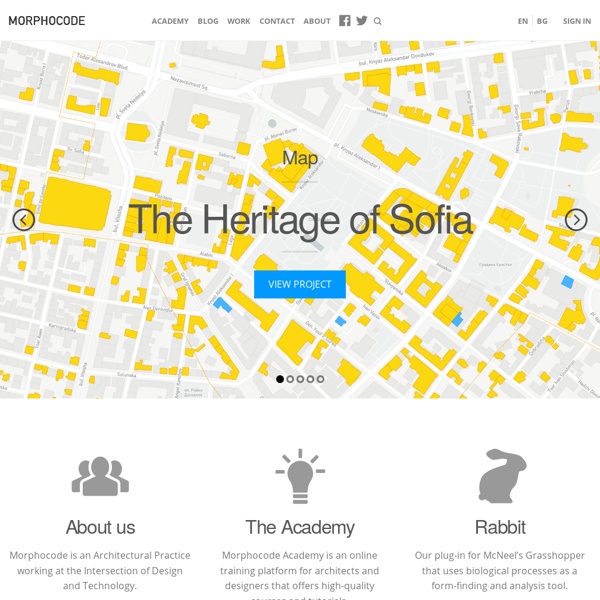



Grasshopper Resources rechenraum - Goat 1.4 The Geometry of Bending Space Syntax | science-based : human-focused WooJae's Blog designcoding Maybe a huge kitsch for contemporary architecture, I know, but a good example of a fundamental problem of constructing geometric relationships. In ARCH362 today, we’ve examined the geometric modeling process that opens us parametric relationships just by converting it into a diagram of design history. You may follow the construction of such a diagram step by step and see the possible parameters emerged from it. You can download the definition file here [GHX: 0.8.0066] Please note that in this method, first, a geometric sketch is made in Rhino to create an initial object. Of course, Grasshopper is not limited with this method of diagrammatic deduction.
gHowl gHowl_r50 and example files Check out the gHowl videos page where you can see how people have been using gHowl. Our users have connected Rhino and Grasshopper to various protocols, platforms, and softwares including: Processing Excel Open Office Arduino Kinect Reactivision openFrameworks Google Earth Resolume Pure Data max/msp Maya Kangaroo TouchOSC iPhone Android Components: UDP Components now have the ability to send and receive to a Multicast group. OSC functionality is provided by the Bespoke OSC Library by Paul Varcholik. Network Source - Tests the connection of your machine to a network. UDP Send - Allows the sending of UDP messages over the network. UDP Receive - Allows the sending and receiving of UDP messages. OSC Channel - This component allows the storage of a single OSC Channel. OSC Dispatch - This component allows the storage of data from multiple OSC addresses. Spreadsheet:The spreadsheet components leverage the OpenXML engine. Spreadsheet Writer - Allows you to write a spreadsheet file.
Daniel Davis Systematica New Fabrications for Architecture The Euclid robot and Ron 2.0 make their first 3D printed object. This was just a simple test print on the Euclid robot now that it is fully up and running, but it came out better than I was expecting. This whole layer based printing business is pretty easy.
Zwarts en Jansma Volatile Prototypes / hoopsnake: Iteration in Grasshopper Update: Hoopsnake is now Opensource! More info at Github HoopSnake, apart from a legendary creature, is a component for the Grasshopper™ 3D platform. What it does in principle is to create a copy of the data it receives at it's input upon user request and store it locally. This duplicate is made available through a standard Grasshopper parameter output. What this means in practice is that it is possible through the use of HoopSnake to send the output of a set of components back to it's input in a looping fashion. The loop can be stopped at any point either by the user or automatically by setting a termination condition (the third input of the component) to false. With the download file examples of various Hoopsnake configurations are included. Licensed under a Creative Commons Attribution-NonCommercial-NoDerivs 3.0 Unported License. Please Note: I am currently unable to offer any assistance for Hoopsnake.
Projects Archives » MEDIODESIGN Projects Musikbox is a conceptual work of synchronized audio and motion created by artist Sergio Roger and architect Fernando Ansorena for the exhibition WEGE UMS KINO (“Tours of Cinema”), Berlin. The work consists of a sculptural piece of Malaparte’s House (Adalberto Libera Arch.) that moves following a melody. The piece was made by CNC milling of an […] General view of the booth at Fira Gran Via, Barcelona. Gironde Extendible Table Robust and architectonic, the table is composed by four triangular pieces that are hidden below the central square board fixed intuitively. SOLID TEAK DOOR FOR A PRIVATE RESIDENCE, Barcelona. YOTA DEVICES PAVILION, MOBILE WORLD CONGRESS, Barcelona. Inspired by a popular Japanese tradition called Kamishibai (paper Drama), Ekaré Sur has entrusted us the technical development and manufacture of this beautiful object for storytelling anywhere, always from a stage. “Microlife” Exhibition Furniture. Spanish Pavilion Installation Prototype. 3D models.